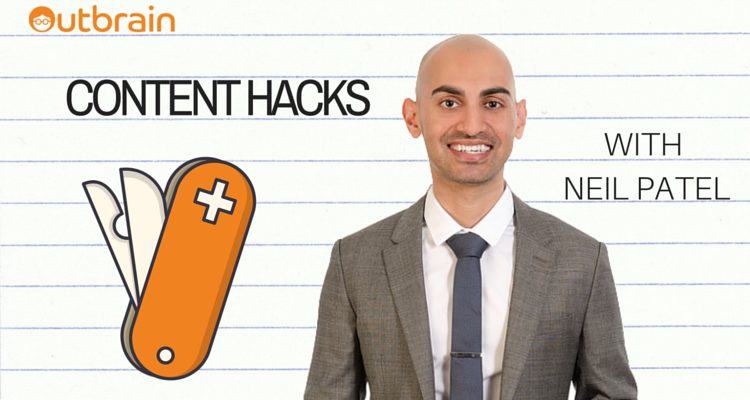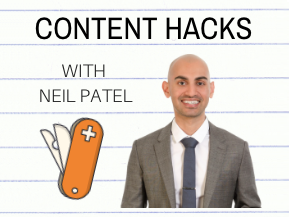3 Easy Hacks That Will Make Any Article 10x Better

I write a ton of content so I’m always on the lookout for techniques that will improve my articles. I guess you can call them “hacks.”
As it turns out, the best content can’t be “hacked” at all. The best-performing content is highly researched, in-depth long form content.
Ah, but there are still some hacks that I use.
In this article, I’m going to pull back the curtain on some of these hacks and explain how a few simple changes can boost the performance, power, readability, and appeal of your articles tenfold.
These worked for me, and I think they will work for you, too.
1. Use short paragraphs
I love short paragraphs.
I think you do, too.
Why? The brain’s visual processing center can interpret chunks of information — words, sentences, paragraphs — quickly and easily.
Here is one of the foremost neuroscience researchers on the subject (Daniel Bor):
Chunking exploits logical or mnemonic redundancies in a dataset so that it can be re-coded and a given task optimized. (Daniel Bor and Anil K. Seth, “Consciousness and the Prefrontal Parietal Network: Insights from Attention, Working Memory, and Chunking”)
What are they saying?
The idea is this: Short bits of information are processed better than long strings of information.
A long sentence is hard to follow. A long paragraph is difficult to read. The solution? Break it up into chunks.
Whatever your English or composition professor told you about longish paragraphs, forget it. Write short paragraphs, and you’ll get people to read and follow your articles much better.
Here’s an example of something I recently wrote for my blog, Quicksprout. Notice the short paragraphs:
You want to be careful with short paragraphs. While it’s smart to keep paragraphs short, you don’t want to use exclusively one-sentence paragraphs for the entire article. That can get monotonous.
It’s like eating popcorn. Lifting one piece to your mouth repeatedly makes your arm tired. Sometimes, you just have to stuff a whole handful in.
2. Use images. Lots of images
The brain interprets images faster than text.
Images can reinforce your written content, but they can also communicate concepts better than you can explain them with words.
The brain is primed to get and interpret information as fast as possible. The brain’s level of response time to an image is nearly instantaneous.
You can find relevant images for nearly any type of content. I’m not advocating stock images being sprinkled throughout an article, but rather images that show, explain, clarify, or reveal.
Let me provide an example.
In this section, I used three images to reinforce my point about the power of images. I think the images are helpful. They are clear, explanatory, and packed with information.
How did I find these images? Easy.
All I do is Google it, but I choose to search for “images” rather than “web.” Instantly, I’ve got plenty of great choices that will jazz up the article.
One simple Google search was all it took for me to get every image you see in this section so far.
Another great source for images is whatever you’re looking at on your screen. A simple screenshot works wonders for explaining concepts.
A little image like this one…
…helps to explain where you should click to search Google for images.
When I explain tools like Google Analytics, I use screenshots like this one:
Here are some more image ideas:
-
Statistics
-
Graphs
-
Charts
-
Cartoons
-
Sections of an infographic
-
A screenshot of a website
-
A screenshot of the SERPs
-
A screenshot of a software tool
-
Any screenshot with your own annotations (arrows, circles, etc.)
When I submit articles to other publications like Forbes, Inc., or Entrepreneur, I don’t use many images in my article, if any. Why not? Mostly, I don’t use images because of the editorial standards that these publications have in place.
While these publications usually don’t refuse images, they have tight policies surrounding the use of images. Besides, if a piece of content is image heavy, they prefer an image-based content form that encourages higher clickthrough rates and dwells time.
Overall, the user interface of my blog is much better suited to featuring images than a website like Forbes or HuffPo.
3. Explain and show exactly how to do something
In my niche — Internet marketing — people want to know how to do certain things. It’s not good enough to motivate, talk about a subject, or provide some “insights.” Readers want to get solid information that they can actually work on, step-by-step.
I’ve made a huge effort recently to show readers exactly how to do certain things in online marketing.
Here’s what my process looks like:
-
I think, “What’s a big problem that my readers are struggling with?”
-
I write down this problem.
-
I ask, “How would I solve this problem?”
-
I solve it.
-
I write down the solution, step-by-step.
-
I publish it as a blog post.
Recently, I wrote an article about PPC ads. A lot of marketers struggle with PPC ads because they’re not getting the ROI they want. It ends up being a waste of money for them.
My readers are smart people. They know the right PPC platforms — Facebook and AdWords. They want to know exactly what to do about their low-performing ads.
I explain exactly what they need to click on, write, and do in order to make their PPC ads effective.
This might sound like it would make for a boring article, right? Click on this…click on that…
Actually, however, this is the kind of article that the right people are intensely interested in. I’m not writing the kind of clickbait that appeals to anyone — “ZOMG! This guy actually saw a zombie in Georgia, and he got it on video! Wait until you see 0:37!”
I’m interested, rather, in creating focused content that a certain segment of the population is craving. If they are interested, then they will click on it, spend time on it, interact with it, and benefit from it.
They win.
As a result, I win, too.
Conclusion
Often, the most powerful ways to improve your articles are also the simplest and easiest.
-
Short paragraphs
-
Lots of images
-
Clear how-to explanations
There’s no substitute for great writing, a polished style, and grammatical finesse. But at the same time, you don’t have to be a Hemingway to pull off stellar stuff.
Give these techniques a try in your next piece of content, and just see if it makes a difference.
What quick and easy tricks have you tried that have created a dramatic improvement in your article writing?


